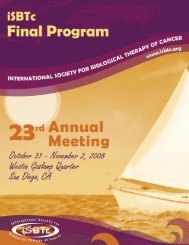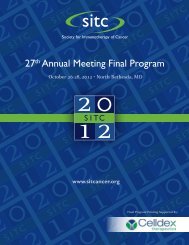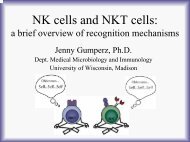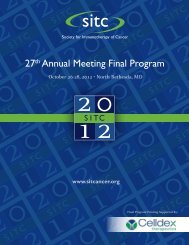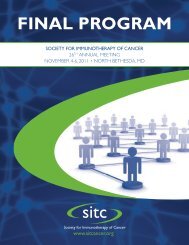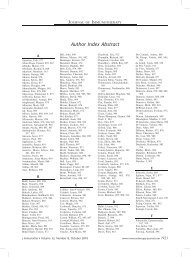Abstracts for the 25th Annual Scientific Meeting of the International ...
Abstracts for the 25th Annual Scientific Meeting of the International ...
Abstracts for the 25th Annual Scientific Meeting of the International ...
Create successful ePaper yourself
Turn your PDF publications into a flip-book with our unique Google optimized e-Paper software.
J Immuno<strong>the</strong>r Volume 33, Number 8, October 2010<br />
<strong>Abstracts</strong><br />
<strong>the</strong> peptides incorporated in <strong>the</strong> vaccine as measured by ELISpot,<br />
and by MHC/multimer reagents. Myeloid populations were identified<br />
by flow cytometry, as a proportion <strong>of</strong> CD45+, lineage (CD3,<br />
CD19, CD56)-negative cells. Mature myeloid suppressor cells (MSC)<br />
were fur<strong>the</strong>r defined as CD14 + HLA-DR, and myeloidderived<br />
suppressor cells (MDSC) <strong>of</strong> two phenotypes were defined<br />
as CD11b + CD33 + DRneg or CD33 + CD15 + . Regulatory T cell<br />
populations also were defined as CD25bright FoxP3+ CD4+ by<br />
multi-parameter flow cytometry. Twenty patients were evaluated,<br />
half in each group, pre and after 4 vaccines. After four weeks <strong>of</strong><br />
weekly immunizations, <strong>the</strong> level <strong>of</strong> MSC did not change significantly<br />
(median 1.7% after vaccine in both groups, Table 1 previous page).<br />
In addition, o<strong>the</strong>r myeloid populations did not change significantly<br />
after immunization+GMCSF (P = 0.7, 0.9, Table 1 previous page)<br />
and were not different between groups (Table 1 previous page). Also,<br />
<strong>the</strong>re was no overall change in regulatory T cells in patients receiving<br />
GM-CSF (P = 0.49, not shown). The suppressed immune responses<br />
associated with GM-CSF in this trial do not appear to be<br />
attributable to any <strong>of</strong> <strong>the</strong>se defined regulatory cell population in<br />
lymphoid or myeloid compartments <strong>of</strong> peripheral blood, but may<br />
operate by o<strong>the</strong>r mechanisms that impact <strong>the</strong> immune response to<br />
tumor-derived peptides.<br />
Blockade <strong>of</strong> TGF-b Receptor Type I Signaling Reduces<br />
<strong>the</strong> Ability Of FoxP3+ Cells to Inhibit Proliferation and<br />
IFN-Gamma Production in Effectors Cells<br />
Magdalena J. Polanczyk, Daniel Haley, Edwin Walker,<br />
Emmanuel T. Akporiaye. Providence Medical Center, Earle A.<br />
Chiles Institute, Portland, OR.<br />
Trans<strong>for</strong>ming growth factor-beta (TGF-b) plays a crucial role in<br />
tumor growth, metastasis and invasiveness. We already demonstrated<br />
that <strong>the</strong> beneficial effect <strong>of</strong> systemic blockade <strong>of</strong> TGF-b<br />
receptor type 1 by a small molecule inhibitor (SM16) in a murine<br />
breast cancer model is T cell dependent. As TGF-b is capable<br />
<strong>of</strong> redirecting peripheral CD4+ T cells toward a FoxP3+ Treg<br />
phenotype, which contribute to immune suppression and tumor<br />
evasion, <strong>the</strong> current studies were designed to evaluate how <strong>the</strong><br />
disruption <strong>of</strong> TGF-b signaling affects Treg function and contributes<br />
to <strong>the</strong> antitumor effects <strong>of</strong> SM16. We demonstrate that<br />
systemic blockade <strong>of</strong> TGF-b receptor type I by SM16 is insufficient<br />
to prevent expansion <strong>of</strong> <strong>the</strong> Treg compartment. Instead, SM16<br />
induced expansion <strong>of</strong> both Treg (CD4+CD25+FoxP3+ and<br />
CD4+CD25-FoxP3+) and effector cell compartments in naı¨ ve<br />
and tumor bearing mice (TBM). Strikingly, <strong>the</strong> SM16-induced<br />
expansion <strong>of</strong> FoxP3+ cells was associated with reduced ability to<br />
inhibit proliferation <strong>of</strong> effectors in in vitro suppression assays.<br />
Finally, SM16 impaired <strong>the</strong> ability <strong>of</strong> FoxP3+ cells to suppress<br />
IFN-g production by CD4+CD25-FoxP3- effector T cells. In<br />
summary, our data suggest that SM16 may promote tumor<br />
immunity by dampening <strong>the</strong> ability <strong>of</strong> FoxP3+ cells to inhibit<br />
proliferation and IFN-g production in effectors cells.<br />
Chronic Chemoimmuno<strong>the</strong>rapy Maintains Long-Term Anti-<br />
Tumor CD8+ T Effector Cell Activity and Results in <strong>the</strong><br />
Cure <strong>of</strong> Advanced Spontaneous Tumors<br />
Rachael B. Rowswell-Turner, Lauren P. Virtuoso, Tao Gu,<br />
Mehmet O. Kilinc, Nejat K. Egilmez. Microbiology and Immunology,<br />
University at Buffalo, School <strong>of</strong> Medicine and Biomedical<br />
Sciences, Buffalo, NY.<br />
Like o<strong>the</strong>r <strong>for</strong>ms <strong>of</strong> cancer immuno<strong>the</strong>rapy, intra-tumoral delivery<br />
<strong>of</strong> microsphere encapsulated IL-12 and GM-CSF leads to only<br />
short-lived tumor regression in <strong>the</strong> Her-2/neu spontaneous<br />
mammary tumor model. IL-12/GM-CSF treatment promotes an<br />
initial loss <strong>of</strong> T regulatory cells from tumors which corresponds<br />
with tumor regression. However, T regulatory cells inevitably reinfiltrate<br />
<strong>the</strong> tumor and tumor growth resumes as CD8+ T effector<br />
cells are rendered nonfunctional. With multiple intratumoral IL-<br />
12/GM-CSF treatments, <strong>the</strong> T-regulatory cell rebound is progressively<br />
exacerbated and tumor specific CD8+ T cells are lost. To<br />
circumvent this counter-regulatory response we have specifically<br />
targeted <strong>the</strong> T-regulatory cell re-infiltration <strong>of</strong> <strong>the</strong> tumor and<br />
draining lymph nodes. Low-dose chemo<strong>the</strong>rapy has been associated<br />
with depletion <strong>of</strong> T-regulatory cells and has been shown to<br />
enhance tumor immuno<strong>the</strong>rapy. In our studies repeated administration<br />
<strong>of</strong> cyclophosphamide and IL-12/GM-CSF microspheres<br />
over a period <strong>of</strong> nine weeks led to complete and durable regression<br />
<strong>of</strong> spontaneous tumors, while ei<strong>the</strong>r treatment alone was ineffective<br />
in achieving long-term cure. Importantly, whereas contribution <strong>of</strong><br />
CD8+ T-cells to tumor regression in <strong>the</strong> immuno<strong>the</strong>rapy alone<br />
group was minimal, tumor kill was strictly dependent on CD8+<br />
T-cells in <strong>the</strong> chemoimmuno<strong>the</strong>rapy group. Fur<strong>the</strong>r analysis<br />
revealed that chemoimmuno<strong>the</strong>rapy enhanced both <strong>the</strong> proliferation<br />
(2-fold) and <strong>the</strong> cytotoxic activity <strong>of</strong> CD8+ T cells (up to 4.7<br />
fold) over that <strong>of</strong> immune <strong>the</strong>rapy alone as assessed by BrdU<br />
uptake and granzyme B, per<strong>for</strong>in, and IFN-g expression. Ultimately,<br />
persistent suppression <strong>of</strong> <strong>the</strong> post-<strong>the</strong>rapy T regulatory<br />
cell rebound led to an elevated activity index (Proliferating CD8+<br />
T cells: T regulatory cells) in <strong>the</strong> tumor, which correlated with<br />
tumor regression. These studies demonstrate that homeostatic<br />
counter-regulation, a major challenge <strong>of</strong> immune-based cancer<br />
<strong>the</strong>rapies, can be overcome by chronic chemoimmuno<strong>the</strong>rapy.<br />
CD4+Foxp3+ Regulatory T Cells are Dependent on PI3K<br />
Pathway Allowing <strong>for</strong> Their Selective Inhibition<br />
Raed N. Samara, Yujun Dong, Maher Abdalla, Mikayel<br />
Mkrtichyan, Laurent Ozbun, Yufei Jiang, Jiahua Qian,<br />
Samir Khleif. Vaccine Branch, NCI, Be<strong>the</strong>sda, MD.<br />
Naturally-occurring Regulatory T cells (Tregs) mediate tumor<br />
immune-evasion. Their depletion or inactivation increases antitumor<br />
responses and decreases tumor burden. In this study, we<br />
identified <strong>the</strong> differences in <strong>the</strong> role <strong>of</strong> PI3K/Akt pathway in T cell<br />
receptor signal transduction in Tregs and conventional T cells<br />
(Tconv), and exploited such differences to selectively deplete Tregs<br />
in vivo, while keeping o<strong>the</strong>r T cell subsets unaffected. We found<br />
that unlike Tconv, Tregs are mainly dependent on <strong>the</strong> PI3K-Akt<br />
pathway <strong>for</strong> polyclonal signaling downstream <strong>of</strong> <strong>the</strong> T cells<br />
receptor (TCR) in vitro. Inhibiting <strong>the</strong> PI3K-Akt pathway by<br />
small molecule inhibitors in Tregs decreased S6 phosphorylation,<br />
and completely abrogated <strong>the</strong>ir proliferation in response to TCR/<br />
CD28/IL-2 stimulation. In contrast, <strong>the</strong>se inhibitors had minimal<br />
effects on S6 phosphorylation and proliferation in Tconv cells. In<br />
vivo, administering PI3K or Akt inhibitors preferentially reduced<br />
<strong>the</strong> number <strong>of</strong> Tregs and Foxp3 mRNA, increased specific CD8<br />
T cell immune responses to vaccination, and resulted in decreased<br />
Treg-dependant tumor growth, which was reversed after reinfusing<br />
Tregs, indicating that inhibitors <strong>of</strong> PI3K and Akt directly<br />
target Tregs in vivo. Accordingly, we conclude that TCR/CD28/IL-<br />
2 signaling is mainly dependent on PI3K pathway in Tregs, but not<br />
in Tconv cells, and inhibiting PI3K and Akt directly target Tregs<br />
both in vitro and in vivo. This <strong>for</strong>ms <strong>the</strong> basis <strong>for</strong> a clinicallyrelevant<br />
selective Treg cell inhibition strategy in vivo using small<br />
molecule inhibitors.<br />
Assessing and Countering Negative Immune Regulation in<br />
Renal Cell Cancer Patients-Results <strong>of</strong> a Randomized Phase<br />
II Trial with IMA901<br />
Steffen Walter*, Norbert Hilf*, Regina Mendrzyk*,<br />
Dominik Maurer*, Toni Weinschenk*, Alexandra Kirner*,<br />
Vincenzo Brontew, Susanna Mandruzzatow, Graham Pawelecz,<br />
Evelyna Derhovanessianz, Arnulf Stenzlz, Carsten Reinhardt*,<br />
Harpreet Singh*. *Immatics Biotechnologies; zUniversity <strong>of</strong> Tuebingen,<br />
Tuebingen, Germany; w University <strong>of</strong> Padova, Padova, Italy.<br />
Background: IMA901 is a <strong>the</strong>rapeutic cancer vaccine <strong>for</strong> <strong>the</strong><br />
treatment <strong>of</strong> renal cell cancer patients based on <strong>the</strong> selection <strong>of</strong><br />
naturally presented tumor-associated peptides (9 HLA-class I- and<br />
1 HLA class II-binding peptides). A previous phase I study<br />
r 2010 Lippincott Williams & Wilkins www.immuno<strong>the</strong>rapy-journal.com | 873



